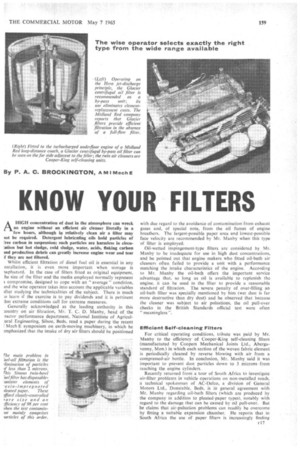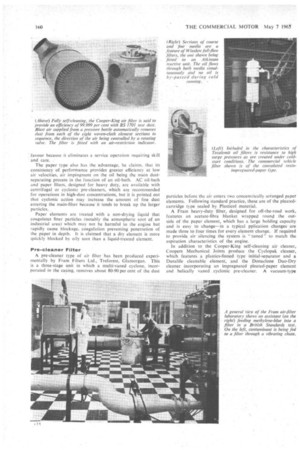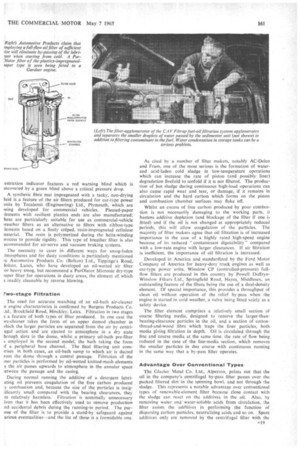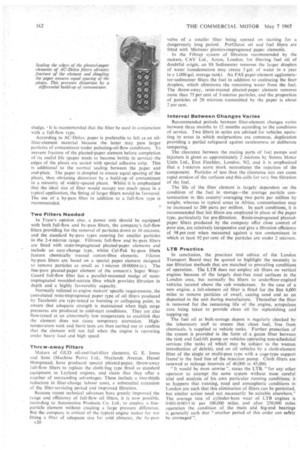The wise operator selects exactly the right type from the
Page 161

Page 162

Page 163

Page 164

If you've noticed an error in this article please click here to report it so we can fix it.
wide range available By P. A. C. BROCKINGTON, A M I Mech E
KNOW YOUR FILTERS
AHIGH concentration of dust in the atmosphere can wreck an engine without an efficient air cleaner literally in a few hours, although in relatively clean air a filter may Sot be required. Detergent lubricating oils hold particles of free carbon in suspension; such particles are harmless in circulation but hot sludge, cold sludge, water, acids, flaking carbon Ind production debris can greatly increase engine wear and tear if they are not filtered.
Whilst efficient filtration of diesel fuel oil is essential in any .nstallation, it is even more important when storage is laphazard. In the case of filters fitted as original equipment, he size of the filter and the media employed normally represent I compromise, designed to cope with an " average " condition, knd the wise operator takes into account the applicable variables tfter studying the technicalities of the subject. There is much .o learn if the exercise is to pay dividends and it is pertinent hat extreme conditions call for extreme measures Generally acknowledged as the leading authority in this :ountry on air filtration, Mr. T. C. D. Manby, head of the ractor performance department, National Institute of Agricul.ural Engineering. Silsoe, Beds, read a paper during the recent [ Medi E symposium on earth-moving machinery, in which he :mphasized that the intake of dry air filters should be positioned with due regard to the avoidance of contamination from exhaust gases and, of special note, from the oil fumes of engine breathers. The largest-possible paper area and lowest-possible face velocity are recommended by Mr. Manby when this type of filter is employed.
Oil-wetted impingement-type filters are considered by Mr. Manby to be inadequate for use in high dust concentrations, and he pointed out that engine makers who fitted oil-bath air cleaners often failed to provide a unit with a performance matching the intake characteristics of the engine. According to Mr. Manby the oil-bath offers the important service advantage that, so long as oil is available to replenish the engine, it can be used in the filter to provide a reasonable standard of filtration. The severe penalty of over-filling an oil-bath filter was specially mentioned by him (wet dust is far more destructive than dry dust) and he observed that because the cleaner was subject to air pulsations, the oil pull-over checks in the British Standards official test were often "meaningless ".
Efficient Self-cleaning Filters•
For critical operating conditions, tribute was paid by Mr. Manby to the efficiency of Cooper-King self-cleaning filters (manufactured by Coopers Mechanical Joints Ltd., Abergavenny, Mon.) in which each section of the woven fabric element is periodically cleaned by reverse blowing with air from a compressed-air bottle. In conclusion, Mr. Manby said it was important to prevent dust particles down to 3 microns from reaching the engine cylinders.
Recently returned from a tour of South Africa to investigate air-filter problems in vehicle operations on non-metalled roads, a technical spokesman of AC-Delco, a division of General Motors Ltd., Dunstable, Beds, is in general agreement with Mr. Manby regarding oil-bath filters (which are produced by the company in addition to pleated-paper types), notably with regard to the damage that can be caused by oil pull-over. But he claims that air-pulsation problems can readily be overcome by fitting a suitable expansion chamber. He reports that in South Africa the use of paper filters is increasingly finding favour because it eliminates a service operation requiring skill and care. .
The paper type also has the advantage, he claims, that its consistency of performance provides greater efficiency at low air velocities, air impinement on the oil being the main dustseparating process in the function of an oil-bath. AC oil-bath and 'paper filters, designed for heavy duty, are available with centrifugal or cyclonic pre-cleaners, which are recommended for operations in high-dust concentrations, but it is pointed out that cyclonic action may increase the amount of fine dust entering the main-filter because ittends to break up the larger particles.
Paper elements are treated with a non-drying Liquid that coagulates finer particles (notably the atmospheric soot of an industrial area) which may not be harmful to the engine but rapidly cause blockage, coagulation preventing penetration of the paper in depth. It is claimed that a dry element is more quickly blocked by oily soot than a liquid-treated element.
Pre-cleaner Filter
A pre-cleaner type of air filter has been produced experimentally by Pram Filters Ltd., Treforest, Glamorgan. This is a three-stage unit in which a multi-vaned cyclone, incorporated in the casing, removes about 80-90 per cent of the dust particles before the air enters two concentrically arranged paper elements, Following standard practice, these are of the pleatedcartridge type sealed by Plasticol material.
A Fram heavy-duty filter, designed for off-the-road work, features an acetate-fibre blanket wrapped round the outside of the paper element, which has a large holding capacity and is easy to change—in a typical pplication changes are made three to four times for every element change. If required to provide air silencing the system is " tuned" to match the aspiration characteristics of the engine.
. In addition to the Cooper-King self-cleaning air cleaner, Coopers Mechanical Joints produce the Cyclopak cleaner, which features a plastics-finned type initial-separator and a Duralife cleanable element, and the Donaclone Duo-Dry cleaner incorporating an impregnated pleated-paper element and helically vaned . cyclonic pre-cleaner. A vacuum-type .estriction indicator features a red warning blind which is incoverect by a green blind above a critical pressure drop.
A synthetic fibre mat impregnated with a tacky, non-drying bid is a feature of the air filters produced for car-type power inits by Tecalemit (Engineering) Ltd., Plymouth, which are wing developed for commercial vehicles. Pleated-paper :lements with resilient plastics ends are also manufactured; hese are particularly suitable for use as commercial-vehicle oreather filters as an alternative to filters with ribbon-type lements based on a finely creped, resin-impregnated cellulose naterial. The resin is polymerized during the helix-winding nocess to provide rigidity. This type of breather filter is also .ecommended for air-servo and vacuum braking systems.
The necessity to cater in different ways for smog-laden itmospheres and for dusty conditions is particularly mentioned oy Automotive Products Co. (Bolton) Ltd., Tippinge's Road, 3olton, Lanes, who have developed an oil-wetted air filter • or heavy smog, but recommend a PurOlator Micronic dry-type oaper filter for operations in dusty areas, the element of which s readily cleanable by reverse blowing.
rwo-stage Filtration The need for accurate matching of an oil-bath air-cleaner
o engine characteristics is confirmed by Burgess Products Co.. Ad., Brockfield Road, Hinckley, Leics. Filtration in two stages s a feature of both types of filter produced. in one case the we7eleaner takes the form of an upper domed chamber in which the larger particles are separated from the air by centringal action and are ejected to atmosphere in a dry state hrough slots in the dome, whilst a primary oil-bath pre-filter s employed in the second model, the bath taking the form of a peripheral base channel. The final filtering unit corn'rises in both cases, an oil-bath sump to which air is ducted root the dome through a central passaee. Filtration or the Liter particles is performed by oil-wetted knitted-mesh elements .s the air passes upwards to atmosphere in the annular space ietween the passage and the casing.
During normal running the additive of a detergent lubriating oil prevents coagulation of the free carbon produced ,y combustion and, because the size of the particles is insigiificantly small compared with the bearing clearances, they .re relatively harmless. Filtration is nominally unnecessary ;iven that it has been effectively used to remove production .nel accidental debris during the running-in period. The puriose of the filter is to provide a stand-by safeguard against arious eventualities—and the list of these is a formidable one. As cited by a number of filter makers, notably AC-Delco and Fram, one of the most serious is the formation of waterand acid-laden cold sludge in low-temperature operations which can increase the rate of piston (and possibly liner) degradation fivefold to tenfold if it is not filtered. The production of hot sludge during continuous high-load operations can also cause rapid wear and tear, or damage, if it remains in circulation and the hard carbon which forms on the piston and combustion chamber surfaces may flake off.
Whilst an excess of free carbon produced by poor combustion is not necessarily damaging to the working parts, it hastens additive depletion (and blockage of the filter if one iJ fitted) 'andif the oil is not changed at appropriately reduced periods, this will allow coagulation of the particles. The majority of filter makers agree that oil filtration is of increased importance in .the case of a highly rated high-speed engine because, of its reduced "contaminant digestibility" compared with a low-rate engine with larger clearances. If air filtration is inefficient, the importance of oil filtration is increased.
Developed in America and standardized by the Ford Motor Company of America for heavy-duty truck engines as well as car-type power units, Winslow CP (controlled-pressure) fullflow filters are produced in this country by Powell DuffrynWinslow Filters Ltd., Springfield Road, Hayes, Middlesex, an outstanding feature of the filters being the use of a dual-density element. Of special importance, this provides a throughput of clean oil without operation of the relief by-pass when the engine is started in cold weather, a valve being fitted solely as a safety device.
The filter element comprises a relatively small section of coarse filtering media, designed to remove the larger-thanbearing-clearance particles in the oil, and a section of cottonthread-and-wood fibre which traps the finer particles, both media giving filtration in depth. Oil is circulated through the fine and coarse media at the same time, the rate of flow being reduced in the case of the fine-media section, which removes the smaller particles in due course with continuous running in the same way that a by-pass filter operates.
Advantage Over Conventional Types
The Glacier Metal Co. Ltd., Alperton, points out that the oil in the company's centrifugal by-pass filter passes over the packed filtered dirt in the spinning bowl, and not through the sludge. This represents a notable advantage over conventional types of renewable-element filter because Close contact with the sludge can react on the additives in the oil. Also, by removing water and water-soluble acids from circulation, the filter assists the additives in performing the function of dispersing carbon particles, neutralizing acids and so on. Spent additives only are removed by the centrifugal filter with the
sludge. • It is recommended that the filter be used in conjunction with a full-flow type.
According to AC-Delco, paper is preferable to felt as an oilfilter-element material because the latter may pass larger particles of contaminant under pulsating-oil-flow conditions. To prevent fracture of the pleated-paper element before completion of its useful life (paper tends to become brittle in service) the edges of the pleats are sealed with special adhesive strip. This is additional to the normal sealing between the paper and end-plate. The paper is dimpled to ensure equal spacing of the pleats, thus obviating distortion by a build-up of contaminant in a minority of widely-spaced pleats. Whilst it is emphasized that the ideal size of filter would occupy too much space in a Typical application, the fitting of larger filters would be favoured. The use of a by-pass filter in addition• to a full-flow type is recommended.
Two Filters Needed
In Fram's opinion also, a power unit should be equipped with both full-flow and by-pass filters, the company's full-flow filters providing for the removal of particles down to 10 microns, and the standard by-pass types catering for smaller particles in the 2-4 micron range. Filtronic full-flow and by-pass filters are fitted with resitAmpregnated pleated-paper elements and include an easy-change type, whilst Cel-Pak by-pass filters feature chemically treated, cotton-fibre elements. Filcron by-pass filters are based on a special .paper element designed to remove particles as small as 1 micron (0-00004 in.). The fine-pore pleated-paper element of the concern's Super. WearGuard full-flow filter has a, parallel-mounted wedge of resinimpregnated moulded-acetate fibre which provides filtration in depth and a highly favourably capacity.
Normally tailored to engine makers' specific requirements, the convoluted resin-impregnated paper type of oil filters produced by Tecalemit arc type-tested to bursting or collapsing point, to ensure that adequate strength is maintained when high surge pressures are produced in cold-start .conditions, They arc also flow-tested at an abnormally low temperature to establish that the element does not• cause temporary starvation. Hightemperature soak and burst tests are then carried out to confirm that the element will' not fail when 'the engine is operating under heavy load and high speed.
Throw-away Filters
Makers of GUD oil-and-fuel-filter elements, G. E. Jones and Sons (Machine Parts) Ltd., :vlaylands Avenue, Hemel Hempstead, have produced special pleated-paper, throw-away full-flow filters to replace the cloth-bag type fitted as standard equipment to Leyland engines, and claim that they offer a number of outstanding advantages. These include a two-thirds reduction in filter-change labour costs, a substantial extension of the filter-servicing period and improved filtration.
Because recent technical advances have greatly improved the range and efficiency of full-flow oil filters, it is now possible, according to Automotive Products Co. Ltd., to employ a fine
particle. element without creating a large pressure difference. But the company is critical of the typical engine maker for not fitting a filter of adequate size for cold climates, the by-pass
F2() valve of a smaller filter being opened on starting for a dangerously long period. PurOlator oil and fuel filters are fitted with Micronie plastics-impregnated paper elements.
In the Filtrap system of filtration recommended by the makers, CAV Ltd., Acton, London, for filtering fuel oil of doubtful origin, an SS Sedirnenter removes the larger droplets of water (condensation may create 5 gal. of water in a year in a 1,000-gal. storage tank). An FAS paper-element agglomerator-sedimenter filters the fuel in addition to coalescing the finer droplets, which eliminates the remaining water from the fuel. The throw-away, resin-treated pleated-paper element removes more than 75 per cent of 5-micron particles, and the proportion of particles of 20 microns transmitted by the paper is about 2 per cent.
Interval Between Changes Varies
Recommended periods between filter-element changes varies between three months to 12 months according to the conditions of service. Two filters in series are advised for vehicles operating in areas in. .which malpractices are common, duplication providing a partial safeguard against carelessness or deliberate tampering,
The clearance between the mating parts of fuel pumps and injectors is given' as approximately 2 microns by Simms Motor Units Ltd., East Finchley, London, N2, and it is emphasized that a 1-micron score mark necessitates the rejection of the component. Particles of less than the clearance size can cause rapid erosion of the surfaces and this calls for very fine filtration of the fuel.
The life of the filter element is largely dependent on the condition of the fuel in storage—the average particle .contamination in this country averaging two parts per million by weight, whereas in typical areas in Africa, contamination may be increased to 200 parts per million. In such conditions, it is recommended that felt filters are employed in place of the paper type, particularly for pre-filtration. Resin-impregnated pleatedpaper filters producedby the company offer close control of pore size, are relatively inexpensive and give a filtration efficiency of 98 per cent when measured against a test contaminant in which at least 92 per cent of the particles are under 2 microns.
LTB Practice
In conclusion, the practices' and advice of the London Transport Board may be quoted to highlight the necessity to use filtration methods that are matched to prevailing conditions of operation. The LTI3 does not employ air filters on vertical engines because of the largely dust-free road surfaces in the London area, but normally fits filters to underfloor-engined vehicles located above the cab -windscreen. In the case of a new engine, a .felt-element oil filter is fitted for the first 6,000 miles to remove particles of swarf, casting sand and so ondeposited in the unit during manufacture. Thereafter the filter is removed for the remaining life of the .engine, scrupulous care. being taken to provide clean oil for replenishing and topping-up.
The fuel oil at bulk-storage depots is regitlarly checked by' the laboratory staff to ensure that clean fuel, free from chemicals, is supplied to vehicle tanks. Further protection of the system is provided in the form of a gauze filter between the tank and fuel-lift pump on vehicles operating non-scheduled' services (the tanks of which may be .subject to' the wanton introduction of debris), and on all vehicles by a cloth-element filter of the single or multi-pass type with a cage-type support frame in the feed line of the injection pump. Cloth filters are renewed at mileage intervals of 40.000 tt', .45,000.
"It would be most unwise ", states the LTB, "for any other operator to attempt the same system without most careful trial and analysis of his own particular running conditions; it so happens that running, road and atmospheric conditions in London are such that this elimination of filters can be permitted, but similar action need not, necessarily be suitable elsewhere." The average rate of cylinder-bore wear of LTB engines is 0-001-0-0015 in per 100,0011 miles, and after 250,000 miles operation the condition of. the main and big-end bearings is generally such that "another period of this order can safely be envisaged ".
























































































































































































































































